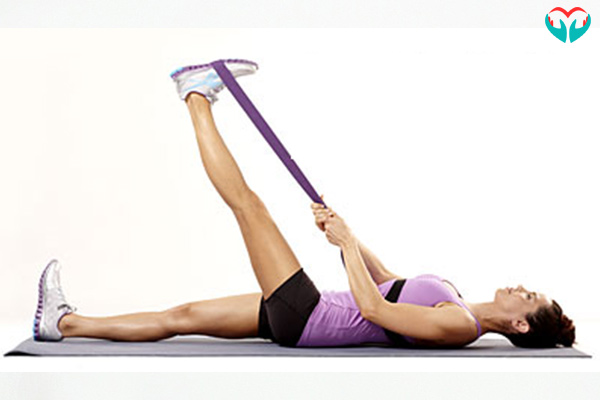1. Lunging Hip Flexor Stretch
"If the hips become tight, your body will rely on and overwork the quads, which puts pressure on the knees," Giordano says. This stretch is an easy way to open up the hips:
Kneel on one knee. Place the opposite foot flat in front of you, front thigh parallel to the floor.
Lean forward, stretching your hip toward the floor.
Tighten your butt; this will allow you to stretch your hip flexor even more.
Reach up with the arm on the same side as the knee on the floor. This will help deepen the stretch.
Switch sides and repeat.
2. Figure Four Stretch
Tight glutes can also cause the quads to take too much impact, consequently putting more pressure on the knees. It can also cause back pain and pain down the leg, Giordano says. Avoiding tightness in the glutes will help them engage better, taking the brunt of the work off your other muscles down the chain. Here's the easiest way to do that:
Lie on your back.
Cross your left foot over your right quad, and bend your right knee.
Hold the back of your right leg and gently pull it toward your chest.
When you feel a comfortable stretch, hold there.
Switch sides and repeat.
3. Standing Hamstring Stretch
The hamstrings help support the hips and knees. It's common that a knee injury is caused by a hamstring strain, "so it's very important that the hamstrings are staying loose and mobile" to help prevent strains, says Giordano. Try this stretch to do just that:
Stand on your right foot with your left foot in front of you, heel on the floor, toes up.
Hinge forward at your hips and bend your right knee as you sit back a bit.
As you bend your right leg, keep your left leg completely straight with your weight on the edge of your heel.
You should feel this stretch in the hamstring of the straightened leg.
Switch sides and repeat.
4. Calf Stretch
Tight calves will put pressure on the back of your knee, Giordano says. This can also put pressure on your feet and contribute to injuries like plantar fasciitis, which causes pain near the heel. Here's a simple way to stretch your calf muscles:
Stand in front of a wall with one leg straight behind you and the other in front of you, slightly bent.
Place your hands on the wall and push against it.
Keep your back leg straight, heel planted on the floor.
You should feel this in the calf of your back leg.
Switch sides and repeat.
5. Quad Stretch
"The tighter the quad is, the more pressure there's going to be on your patella, which is the kneecap," says Giordano. Tight quads can cause pain that feels like it’s coming from behind the kneecap. Do this stretch to relieve some of that tension:
Lie on one side.
Keep the bottom leg straight and bend the top knee so your foot is by your butt.
Hold the top foot with your hand, pulling it toward your butt.
You should feel this stretch in your quad.
Keep your hips stable so you're not rocking back as you pull.
Switch sides and repeat.
6. Kneeling Quad Stretch
This stretch will also help loosen up the quads and take tension off the knees and hips:
Kneel on one knee with the opposite foot flat in front of you.
Grab your back foot and pull it in toward your butt.
Switch sides and repeat.
7. Side Lunge
This stretch works the adductors, the muscles on the inside of your thighs that help stabilize your hips. Tight adductors can cause instability in your hips and pelvis, and ultimately your knees, Giordano says. Here's a great way to stretch them out:
Lunge out to one side, bending the knee and keeping the opposite leg straight.
Try to keep the foot of your straight leg on the floor as much as as you can.
Place your fingertips on the floor in front of you to balance if you need it.
You should feel this stretch in your hips and inner thighs.
Switch sides and repeat.



 Contact Us
Contact Us






 Hospitals
Hospitals
 Doctors
Doctors
 Diagnostic
Diagnostic
 Pharmacy
Pharmacy
 Health Tips
Health Tips
 Blog
Blog


















